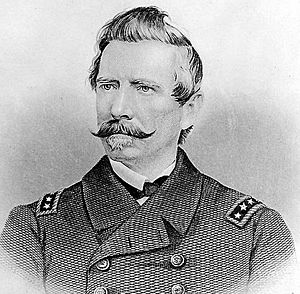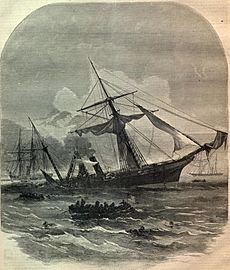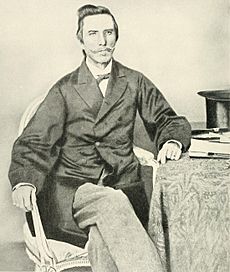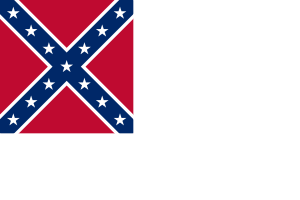Raphael Semmes facts for kids
Quick facts for kids
Raphael Semmes
|
|
|---|---|
 |
|
| Born | September 27, 1809 Nanjemoy, Maryland |
| Died | August 30, 1877 (aged 67) Mobile, Alabama |
| Allegiance |
|
| Branch | |
| Service years | 1826–1861 (USN) 1861–1865 (CSN) |
| Rank | |
| Commands held |
|
| Wars | |
Raphael Semmes (simz; September 27, 1809 – August 30, 1877) was an important naval officer during the American Civil War. He served in the Confederate Navy. Before the Civil War, he was an officer in the U.S. Navy from 1826 to 1860.
During the Civil War, Semmes was the captain of the ship CSS Alabama. This ship was famous for capturing many enemy merchant ships. It captured 65 ships, making it one of the most successful "commerce raiders" in history. Later in the war, he became a rear admiral. For a short time, he also served as a brigadier general in the Confederate States Army.
Contents
Raphael Semmes was born in Charles County, Maryland. He was related to other important figures, including a future Confederate general and a Union Navy captain.
He studied at Charlotte Hall Military Academy. In 1826, he joined the U.S. Navy as a midshipman. He also studied law and became a lawyer. In 1837, he was promoted to lieutenant.
Service in the Mexican-American War
During the Mexican–American War, Semmes commanded the ship USS Somers. This ship was in the Gulf of Mexico. In December 1846, a strong storm hit the Somers near Veracruz. The ship sank, and 37 sailors were lost.
After this, Semmes served on another ship, the USS Raritan. He also went with soldiers who landed at Veracruz. He then traveled inland to join the army moving towards Mexico City.
Life Before the Civil War
After the Mexican-American War, Semmes took a long break. He lived in Mobile, Alabama, where he worked as a lawyer. He also wrote a book about his experiences in the war. He became very popular, and a town nearby, Semmes, Alabama, was named after him.
In 1855, he was promoted to commander. He worked on lighthouse duties until 1860. When Alabama left the United States, Semmes was offered a position in the new Confederate Navy. He resigned from the U.S. Navy the very next day, on February 15, 1861.
After joining the Confederate Navy, Semmes was sent to New Orleans. His task was to turn a steamer called Habana into a warship. This ship became the CSS Sumter. In June 1861, Semmes, on the Sumter, managed to get past the Union blockade of New Orleans. This started his amazing career as a "commerce raider."
Semmes commanded the CSS Sumter for six months. During this time, he traveled widely, attacking U.S. merchant ships. He operated in the Caribbean Sea and the Atlantic Ocean. He captured 18 merchant ships and always avoided being caught by Union warships. By January 1862, the Sumter needed major repairs. Semmes had to pay off his crew and leave the ship in Gibraltar. Union ships watched the harbor until the Sumter was sold.
Semmes and some of his officers then went to England. There, he was promoted to captain. He was ordered to the Azores to take command of a new British steamer. This ship was fitted with cannons and became the famous Confederate commerce raider, CSS Alabama.
The CSS Alabama's Journey
Semmes sailed on the Alabama from August 1862 to June 1864. His travels took him from the Atlantic to the Gulf of Mexico. He sailed around Africa's Cape of Good Hope and into the Pacific to the East Indies. During this long journey, the Alabama captured 65 U.S. merchant ships. It also quickly sank the USS Hatteras near Galveston.
The Alabama eventually sailed back to the Atlantic. It stopped in Cherbourg, France, for much-needed repairs. However, the Union warship, USS Kearsarge, soon arrived and blocked the port.
Battle with the USS Kearsarge
On June 19, 1864, Captain Semmes took the Alabama out to sea. It met the Kearsarge in one of the most famous naval battles of the Civil War.
The commander of the Kearsarge had secretly added extra protection to his ship. He had covered 30 feet of the ship's sides with heavy chain armor. This armor was hidden behind black-painted wooden covers. The Alabama's gunners fired too quickly and often missed. Also, their gunpowder and shell fuses were old. This helped the Kearsarge win the battle.
The Kearsarge had two powerful 11-inch Dahlgren cannons. The Alabama opened fire from a distance. The Kearsarge steamed straight towards it, then turned to fire its broadside. Soon, the heavy cannons of the Kearsarge began to hit their target.
A fatal shell hit the Alabama's side, tearing open its hull. This caused its steam engine to explode. Semmes was forced to order his ship's battle flag to be lowered. He then showed a white flag to surrender.
As the Alabama sank, the Kearsarge stayed a short distance away. Its captain, John Ancrum Winslow, eventually sent rescue boats for survivors. Semmes, who was wounded, threw his sword into the sea. This meant he did not have to hand it over to Captain Winslow as a sign of surrender. Semmes and 41 of his crew were rescued by a British yacht called Deerhound and three French pilot boats. They were taken to England, where they were seen as naval heroes.
From England, Semmes traveled back to America through Cuba. He landed safely on the Texas coast. It took him many weeks to travel through the war-torn South. He finally reached the Confederate capital. In February 1865, he was promoted to rear admiral. In the final months of the war, he commanded the James River Squadron. His main ship was the heavily armored ironclad CSS Virginia II.
When Richmond fell in April 1865, Semmes oversaw the destruction of all the squadron's warships. He then acted as a brigadier general in the Confederate States Army. This appointment was informal and not officially confirmed.
After the naval squadron was destroyed, Semmes's sailors became an infantry unit called the "Naval Brigade." Semmes was put in command. He wanted his brigade to join General Robert E. Lee's army. However, Lee's army was already cut off. So, most of Semmes's men took a train to join General Joseph E. Johnston's army in North Carolina. A few men from the Naval Brigade did join Lee's rear guard and fought at the Battle of Sailor's Creek.
Semmes and the Naval Brigade surrendered to Union Major General William T. Sherman. This happened with Johnston's army at Bennett Place near Durham Station, North Carolina. Semmes was released on May 1, 1865. His release papers noted he held commissions as both a brigadier general and rear admiral. He wanted this included because he thought the U.S. government might accuse him of piracy.
After the War

After the war, the U.S. government briefly held Semmes as a prisoner. He was released, but then arrested again in December 1865. After some political discussions, all charges were dropped. He was finally released on April 7, 1866.
After his release, Semmes worked as a professor at Louisiana State Seminary (now Louisiana State University). He also served as a county judge and later as a newspaper editor. Semmes eventually returned to Mobile and continued his law career.
In 1869, he wrote a book called Memoirs of Service Afloat During The War Between the States. In this book, he defended his actions at sea and the Southern states' political choices. Semmes helped make the phrase "War Between the States" popular for referring to the American Civil War.
In 1871, the people of Mobile gave Semmes a house, known as the Raphael Semmes House. He lived there until he died in 1877. He passed away from problems after eating bad shrimp. Semmes was buried in Mobile's Old Catholic Cemetery.
Legacy and Recognition
Raphael Semmes is a member of the Alabama Hall of Fame. A street on the Louisiana State University campus was once named after him. Semmes Avenue in Richmond, Virginia, is also named in his honor. A life-sized statue of Admiral Semmes in Mobile was removed in June 2020. A suburban area in western Mobile County is named for him, as is The Admiral Hotel in downtown Mobile.
When Semmes returned to the South from England, he brought a special ceremonial flag with him. This was a "Stainless Banner" (the second national flag of the Confederacy). His grandchildren inherited it. In 1929, his grandson donated the flag to the state of Alabama. Today, this battle flag is kept in the Alabama Department of Archives and History. It was given to Semmes in England by "Lady Dehogton and other English ladies" after the Alabama sank.
See also
 In Spanish: Raphael Semmes para niños
In Spanish: Raphael Semmes para niños





